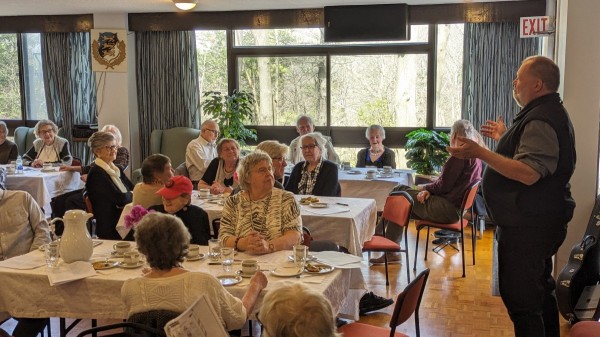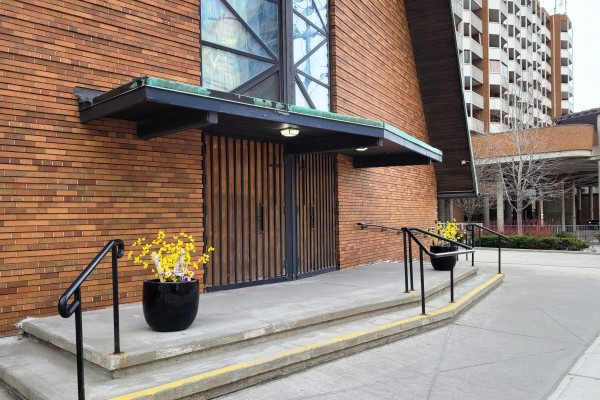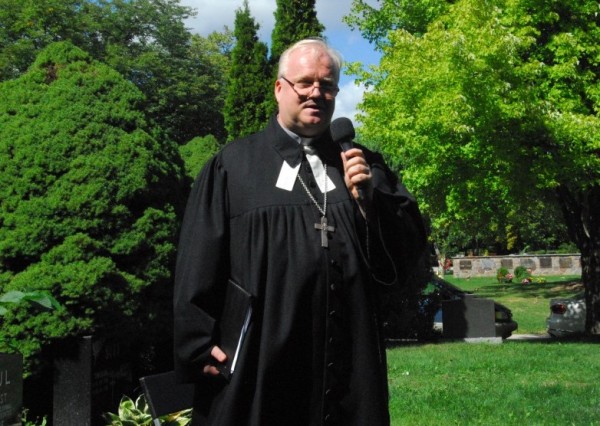
SOLD. The deal to sell Eesti Maja might be "Conditional" but the sense of loss is no less devastating for many.
On the 31st a seemingly sparse group of community members came together at a townhall meeting to hear news about the Madison Project and view updated renderings of its design. Some of the details released included:
- The Estonian House Toronto Limited (EHL) Board has executed a conditional purchase-sale agreement for 958 Broadview Ave.;
- From 16 interested groups the 4 Orgs got down to 5 Letters of Intent that were reviewed;
- Purchase offers ranged between $12-18 million;
- The EHL Board accepted the offer that provided the greatest value, flexibility and added benefits;
- The unnamed purchaser is an owner-operator of seniors residences and care centres;
- The purchaser may offer some spaces dedicated to Estonians looking for retirement or assisted living accommodations;
- The closing price will be based, in part, on the purchaser's due diligence (i.e. soil analysis, impact of heritage restrictions, zoning allowances etc.);
- The closing price will also be conditioned by the height allowed for any new building at 958 (currently the Broadview Development Plan restricts construction to 6 storeys);
- EHL will have a 15 month "leaseback" period to help transition to Madison;
- EHL's "leaseback" will be for $0 per month, but EHL will be responsible for operational expenses and property taxes assessed during the 15 months;
- A contract has been completed with Build Toronto regarding 9 Madison;
- The Estonian Toronto Credit Union, The Estonian Foundation and Tartu College signed the agreement for 9 Madison with Build Toronto;
- A final closing on the purchase-sale agreement for 9 Madison has to be approved by City Council Committee;
- 9 Madison closing is also conditional on site plan approvals and finalizing arrangements with the TTC regarding construction protocols over the tunnels.
Other items that were raised and discussed (in no particular order):
- Representatives from the 4 Orgs will hold a series of meetings with community groups to review user specific requirements (i.e. lasteaed, scouts and guides, etc.);
- 20-25 financially qualified Estonian-Canadians are being solicited and interviewed as part of a "capital" campaign to gauge their funding and donation interests;
- It is anticipated that the full design of the Estonian Centre will be completed by June of this year;
- Current estimates for maximum available space within the Centre are in the range of 31,000 square feet and an alternate plan for 22,000 square feet is being considered if fundraising cannot be maximized;
- Shovels are expected to go into the ground starting April 2019;
- The project is scheduled to be completed by June 2020;
- The "leaseback" of Eesti Maja is schedule to end in November 2020;
- EHL will purchase 11 Madison from the credit union for approximately $3 million in September of this year;
- The $10 million loan taken by Tartu College in 2013 will mature in December 2018 and at renewal the balance should be approximately $8 million;
- Although it was not explicitly addressed, the balance of a $1 million loan taken by Estonian Foundation to purchase 72 Chester Hill in 2011 should be retired when the purchase of Estonian House is finalized.
Considering its “prime” downtown location, the City seems poised to sell 9 Madison for a relatively affordable price tag at under $2 million. Perhaps the favourable sale price is a byproduct of Ward 20 Councilor Joe Cressy’s advocacy for the proposed Estonian Centre. The Councillor's office announced that a new 29 storey condo will rise at 316 Bloor St. W. (See http://www.joecressy.com/316_b...) A 38 storey condo may be built at 300 Bloor St. W. right on top of the same subway tunnel that the Estonian Centre will bridge. (See http://urbantoronto.ca/news/20...) The value of land and long-term revenue generated from condos can't be denied. Could Toronto tax payers get the short end of the revenue stick by following Cressy's advice on 9 Madison? For example, if 300 Bloor West were extended westerly onto 9 Madison that could increase the number of available condos, generate valuable property tax dollars for the City’s coffers and host some public parking. More living space, more tax revenue and more parking could be a fail proof combination. Additional parking alone would be a great plus. As far back as 2008 a local college president warned that if parking on the 9 Madison lot was lost, severely overburdened streets would see even greater competition for spots. (See https://www.insidetoronto.com/...) Nevertheless, Councilor Cressy continues to soapbox for the two storey Estonian Centre and a public walkway shadowed by 2 towering condo developments. Cement truck traffic jams and dueling cranes are inevitable for the area surrounding Madison and Bloor for the coming years.
Parking, traffic and development in the Annex will continue to be hot button issues but their impact can be mitigated and managed by those who live or frequent the area. Ultimately it's up to the City, local residents, businesses and other stakeholders in the Annex to figure it out. With the announcements made on the 31st, additional announcements to be made at three more information townhalls and an Estonian House Limited shareholders meeting on February 12th, Estonian-Canadians have much more serious issues to deal with. This "Due Diligence" series has generally focused on 3 broad themes: Timing (and Pace); Transparency and, thirdly, Legacy. After starting on a more pronounced and methodical process, the time given to publicly consider this significant Madison undertaking has been relatively short. The pace that major decisions have been analyzed and executed seems very rapid. Transparency, or the lack thereof, has been trumped almost entirely by non-disclosure agreements. The fact that critical information continues to be held in confidence regarding funding and the parties involved in the sale-purchase arrangements troubles more than a few shareholders that craved for greater visibility. Needless to say, the implications for our collective legacy are monumental. Frankly, Tartu College is not worthy to carry that legacy forward.
Estonian House Toronto Limited (EHL) is organized as a share corporation acting as a not-for-profit. In the 1950’s, EHL was established to support the purchase of a cultural center for Estonians in Canada. After a decade of extensive work EHL brought the community together at 958 Broadview Ave and the Chester Public School building. Our community remains eternally indebted to the ingenuity and dedication of people like Aino and Ludvig Raun. In 2010-2011, the EHL Board began to investigate opportunities to redevelop the Broadview property as part of a cooperative venture with a major partner. EM2 would potentially be 2 or 3 lower floors with condominiums on upper levels. Three properties neighbouring the Estonian House were combined in the redevelopment project to make the investment more attractive to the eventual developer. Early on the EHL Board considered partnering with Ehatare, and then Tartu College. After both concepts were deemed incompatible, a methodical and patient process proceeded. But unknown to most in the community, privately, the Tartu College option never really left consideration. In fact, right after the April 27th vote, some in the community were on Facebook claiming credit for coming up with the Madison concept years before. In fairness to EHL shareholders, Madison should have been deliberated when it was first entertained by any of the 3 Orgs; that would have essentially taken us all back to 2013 or earlier.
When EHL solicited interest from developers, its anchor tenant, the Estonian (Toronto) Credit Union Ltd. (ETCU) looked for interim office space. To support continuity of banking services at a location familiar to Toronto-Estonians, ETCU acquired 11 Madison Ave behind Tartu College for $2.3 million in February 2014. (See https://www.estoniancu.com/pre...) Well known as a student residence on Bloor St West, Tartu College is also home to a cultural archive, museum, newspaper and serves as an active host for many events benefiting the Toronto-Estonian community. No one would have anticipated that ETCU’s announced relocation to a heritage building in the Annex and its 2013 loan to Tartu (only two months earlier) may have been a subtle signal that the future of Estonians on Broadview Ave was no longer a certainty.
For the EHL Board, one unannounced redevelopment opportunity with Windmill was followed by two separate processes with Tribute Communities and Alterra that enjoyed support from 90% of EHL’s shareholders. In subsequent years the EHL Board announced that both processes with Tribute and Alterra had failed. No specifics were ever disclosed.
Last April, six months after the Alterra deal failed, the EHL Board sought a mandate to sell 958 Broadview and make proceeds of that sale the largest financial contribution toward a new Centre’s construction. Entertaining bids for Broadview was supposed to be contingent on a due diligence analysis that would determine Madison’s feasibility and sustainability. From an operational perspective, that sustainability model remains largely undefined. The EHL board continued with a highly secretive bidding process that was ultimately limited to 16 parties. A Request For Information (RFI) or term sheet outlining the desired conditions for the outright sale of the property was not widely released. Nevertheless, a deal is done. Aside from knowing the general business model of the purchaser, shareholders have no name. Concurrently, details of a proposed transaction with Build Toronto to purchase 9 Madison, a green P parking lot between Tartu and 11 Madison, have not been released. The direction of funds generated from the sale of properties owned by the Estonian Foundation of Canada and how they may be part of the $12-18 million purchase price has not been specified. Sources for additional construction funding are identified as "benefactors" but no details are available. Anchor tenants for Madison have not been announced. The ownership and governance structure related to the Estonian Centre remains to be the subject of future community consultations.
During all the activity, two EHL board members resigned.
The "Conditional" purchase-sale agreements and the due diligence process have been executed to make Madison work. If there was a graph to display the 4 Org's due diligence assessment it may only need 2 columns. The first column would show the "Pro" Madison points stacked on top of the "Con" Estonian House points in two shades of red. A second column made up of two shades of blue would show the "Con" Madison points stacked on top of any "Pro" Broadview points. The 2 columns juxtaposed would show the "Pro" Madison red column looking something like the height of Tartu College dominating over a blue two storey column representing "Pro" Estonian House.
The Madison process has entered a critical stage. Financial transactions and corporate activities related to the disposition of Estonian House require continued community oversight. So should management of assets under the control of the "3 Orgs": Tartu College, The Estonian Foundation of Canada (a charitable foundation) and the Estonian (Toronto) Credit Union. For example, as noted in Schedule A the boards of 4 Orgs stated that they desired a strategy that would allow “the proceeds of an Estonian House sale to be directed to the project with minimal tax consequences.” (Appended to the Recitals and Resolutions of a Special Meeting of The Estonian House Toronto Limited on April 25, 2017) Background research on potential tax strategies for Madison yielded a Toronto Star article written by James Daw in 2007. (See https://www.thestar.com/opinio...) Daw’s article described how “donations” to a charity sheltered corporate revenue that would have otherwise been taxable. EHL shareholders should remain vigilant regarding any proposal where funds generated by the sale of 958 Broadview are generously donated to a charity or new non-share corporation acting for the Estonian Centre.
Ironically, the sale of 958 Broadview will represent the majority of Madison’s funding, as such, EHL should be the majority equity stakeholder. For the sake of its current shareholders, the EHL Board should have been leading the Madison Project process and performing due diligence completely independent of the other three organizations. Yet Madison is on a path that could irreversibly change the structure and governance of Estonian-Canadian organizations for generations to come. For one thing, it is quite possible Madison's future structure could lead to the dissolution of Estonian House Toronto Limited. If that happens, Estonian Centre may be organized and operate at the sole discretion of a board with no further accountability to pesky members or squeaky shareholders.
How could a proposed plan to preserve Estonian-Canadian culture mask a series of seemingly unrelated but embarrassing misrepresentations, conspicuous activity and business interests that have transpired over decades? For Estonian diaspora that came, settled, prospered and assimilated to the Canadian way of life, the “Madison Project” may be a culminating act of collusion solidifying entitlement for a subset within our community. Respective of transparency, due diligence and legacy, the Madison Project warrants greater review.
On January 27th, 2015 where a Letter of Intent (LOI) with Tribute was ratified at a Special Estonian House Shareholder’s Meeting, explanations were offered as to how proceeds from the sale of neighbouring assets held by the Estonian Foundation would be handled. It was proposed that three properties, that were all supposedly owned by the charity, would add financial support to the redevelopment of Estonian House on Broadview. When the Estonian House Ltd (EHL) board was asked by one of its shareholders “How is the Foundation being compensated for their properties?,” the answer provided by one EHL director was: “They are selling their properties to the Estonian House for fair market value.” That general plan was confirmed by the Estonian Foundation of Canada's VP, Eva Varangu. At that meeting Ms. Varangu also represented that the 3 neighbouring properties were owned by the Foundation. However, that representation was not exactly accurate.
Certainly, having 4 properties bundled under a single transaction with a developer continues to be practical. All combined, the Estonian House (958 Broadview), the Foundation office (956 Broadview), the second half of the semi-detached (954 Broadview) and a house along an adjacent laneway (72 Chester Hill) offer a developer a sizeable area. The community update provided on the 31st did nothing to clarify how these properties were being handled within the conditional purchase-sale agreement. For one thing, the 3 neighbouring properties are owned by multiple parties. When the semi-detached properties of 956 and 954 Broadview became available in 2007 they had one owner. On the date of purchase, the Foundation bought 956 Broadview but its sister-semi 954 was purchased by 6 individuals as tenants-in-common. (See File # 12 and File #13) The six well-intentioned individuals were associated to Sihtkapital: Alfred Nielander, Lia Hess, Andres Taul, Eva Varangu, Peeter Poldre and Toomas Kutti.
In 2007 the Foundation was regulated, in part, under Ontario’s Charities Accounting Act. As a Carter’s legal bulletin explains: “(Charities Accounting Act) section 8 restricted ownership of real estate by a charity in Ontario by requiring that a charity that holds land for a charitable purpose could only hold such land for the purpose of its actual use or occupation for that charitable purpose. A charity which held land for over three years, and during those three years had not used or occupied that property for the charitable purpose, nor was likely to do so in the immediate future, faced the prospect of having the Public Guardian and Trustee vest that property in itself in order to sell it and use the proceeds for the charity’s charitable purposes.” http://www.carters.ca/pub/bull... That restriction ended in 2009 with the passage of Bill 212, the Good Government Act (“GG Act”). The GG Act allowed charities to own real estate like any other investment and allowed charities to own those investments for as long as they brought value to the charity. As early as 2010, the Foundation could have taken ownership of 954 Broadview from the 6 well-intentioned, current and former Board members. It did not.
In 2011, 72 Chester Hill came on the market. Bordering the Estonian House parking lot, the location enhanced the potential of expanding Estonian activities on Broadview. Considering how real estate prices were growing and have grown since, any “prudent investor” with cash would have made that investment. But the Foundation did not have excess cash in hand when it made that investment. A financing package provided by Estonian Credit Union (ETCU) was significant. (See File #14) The price of 72 Chester Hill was $715,000.00 and to buy the property the Foundation was furnished with a loan of $1,000,000.00. To cover the loan, the Foundation used 956 Broadview (its office) as collateral for approximately $285,000.00 of debt. Financing 72 Chester Hill provided the Foundation’s board another opportunity to reorganize the ownership of 954 Broadview. But that opportunity was not taken, so 954 could not be used as collateral. Now that 72 Chester Hill and 956 Broadview are "conditionally" sold, ETCU’s loan will be paid out. There should also be a fair amount of equity remaining that will benefit the Foundation's activities. Since 954 Broadview is presumably part of this deal, the 6 well-intentioned owners may be faced with the arduous process of paying capital gains tax then gifting the remaining proceeds to the Foundation to get their tax receipts.
Over the past decade the Estonian (Toronto) Credit Union (ETCU) has been increasingly activist in picking winners and losers within the Toronto-Estonian community. According to its charter the Estonian House Limited was established to own property for the benefit of Estonian-Canadians. That charter should have made EHL a more pragmatic choice to purchase and own neighbouring properties that the Foundation eventually acquired in 2007 and 2011. EHL could have managed those assets, generated rental/lease income and broadened its asset portfolio. From a loan-to-value perspective Estonian House provided the credit union greater collateral for financing the purchases of 72 Chester Hill as well as 954 and 956 Broadview. Perhaps personal relationships and confidences shared between ETCU and Foundation board members were stronger than with Estonian House leadership. However, as a charity, the Foundation did not have 100% certainty when it came to the level of income or donations they may have taken in year over year which would have been contrary to standard lending practices that rely on stable income streams and measuring debt service ratio versus income.
Arguably ETCU’s decisions to facilitate financing to certain parties while disregarding the re-investment and valuation potential of Estonian House is a question only the leadership of the credit union can answer. There should be no doubt the significant role ETCU currently has in directing the EHL board to act in favour of Madison. Without ETCU’s votes, the resolutions granting the EHL board authority to get involved in the Madison Project would not happen. Without ETCU’s votes and influence, resolutions passed in April 2017 may not have directed EHL to purchase the otherwise vacant 11 Madison. Without ETCU’s votes and influence, resolutions may not have involved using funds from the sale of Estonian House to reimburse ETCU for Madison’s $750,000 “due diligence” budget.
How ETCU obtained EHL shares when others could not is an increasingly important question. For example, when the Borough of East York’s approval of the elevator installation was announced, there could have been a public campaign to invite individuals to buy new shares to sponsor the project. (Vaba Eestlane / Free Estonian published July 6, 1995 https://dea.digar.ee/cgi-bin/d... ) At the time, Estonian House might have been worth $2 million on the open market. The elevator construction project cost was approximately $150,000. There were approximately 4000 EHL shares outstanding. A simple formula was applied which took the Estonian House value divided by number of shares to determine an estimated face value per share. ($2 million ÷ 4000 = $500) The elevator construction cost was then divided by the estimated face value per share to calculate the number of shares ETCU would gain. ($150,000 ÷ $500 = 300) At the end, ETCU was given 300 shares in exchange for investing in the project. ETCU acquired shares for fair value and EHL shareholder value was not diluted. At a later date, ETCU bought $10,000 worth of EHL shares to cover an Estonian House deficit but this time a $50 value per share resulted in ETCU gaining 200 more shares. ($10,000 ÷ $50 = 200) Before the elevator and deficit shares, ETCU only had 214 shares.
As an aside, the formula used to sell 300 shares to ETCU at $500 per share during the elevator project raises an interesting question. Does that transaction set a precedent for share value? If, for example, EHL is dissolved and shareholders are paid back for their shares when assets of the corporation are sold at the time of dissolution, is a $500 per share face value the benchmark setting price. Perhaps ETCU has inadvertently established a value that EHL shareholders may benefit from in the future.
Now the Estonian House roof needs repair. A successful grant application to the City of Toronto was sparked by shareholders and volunteers passionate about the well-being of the Estonian House. Instead of selling shares or soliciting donations to generate “in-kind” funding that the City’s grant requires, EHL’s board seems resolved to borrow more money from ETCU. Unfortunately, that decision will translate into more debt and yield more influence over EHL’s management to the credit union. Certainly no one is suggesting that a fundraising campaign for the roof project would compete or distract anyone from fundraising efforts benefiting Madison; are they? A new EHL share sales campaign supporting roof repairs could alleviate a new debt and reinforce previous share value.
Why is Madison being proposed as the new “Centre” of the Estonian-Canadian community? Apparently our legacy needs a reboot or a revival, and a new presence will give us a resurgence of interest that will sustain our community. However, moving also means that our Estonian-Canadian legacy and heritage will now be tied to the story of Tartu College. Considering the events reviewed in the newly released findings of the Ontario Association of Architects, the idea of that linkage may make many shudder at the thought.
Under a program administered by Minister of State for Urban Affairs Ron Basford there were five college residences that were constructed with financing from Canadian Mortgage and Housing Corporation (CMHC). CMHC provided 90% of the construction funds for each building on 50-year mortgage terms. An employee for one company, Vincent Lapetina, wrote to CMHC in September 1971 outlining irregularities and improprieties between corporations linked to the construction of student residences: Tartu College (Toronto), Rochdale (Toronto), Neill Wyck (Toronto), Pestalozzi (Ottawa) and a complex in Waterloo, Ontario. Lapetina’s story had a significant Toronto-Estonian element to it. Lupetina’s original letter was not provided even after two Access To Information Requests but contents of his letter were referenced in other forums.
Lapetina’s testimonial outlined how two key individuals controlled funds for their benefit using various companies. Elmar Tampold and John Malcolm Wells were part of 6 companies that included a finance management group (Cooperative College Residences Inc.), a service management company (Student Management Services Limited), their own architectural firm (Tampold and Wells Architects), a construction company (A.C. Murphy Construction), a property management firm (Warden Building Management Limited, where Mrs. Wells and Mrs. Tampold were Directors) and Galway Realty Limited (a subsidiary of A.C. Murphy Construction). Each company was intertwined in the student residence initiative by contracting jobs and tasks to the other. Each company had central figures in ownership or shared common directorships that managed the flow of work and money. Peter Moon’s article on September 9, 1974 in the Globe and Mail “The Student Co-op Mess” outlined the profiles of Wells and Tampold and their alleged activities. (See File #1) Findings from a supposed inquiry that reached the federal cabinet were not made public back in 1973. However, the problems plaguing the student residence projects were a hot topic of discussion during multiple Question Period sessions in Parliament. (See File #2 references from the Parliament of Canada Hansard). No documents related to the federal inquiry were released after Access to Information Requests were made in 2017.
One of the areas reportedly investigated were a series of "lease" agreements (30-50 year terms) between Student Management Services Ltd and three of the student residences. In fact, Tartu College's land registry documents note a lease (expiring July 2020) to Glentree Investments Limited, a successor to Student Management Services. (See File #3) When he was asked at the townhall session on the Jan 31st if such leases existed, Mr. Meri responded that he knew of none. News media covered the story back in the 1970’s and exposed that the architects hired Robert Wright, an attorney with ties to Mitchell Sharp and Prime Minister Pierre Trudeau, just before the investigation into the college residence-CMHC scandal got shuffled aside. Even though the details of the federal investigation are still unknown, an independent investigation by the Ontario Association of Architects (“OAA”) on Elmar Tampold and John Malcolm Wells found both guilty of professional misconduct and "desirable in the public interest that their membership be suspended or cancelled." Mr. Wright represented Tampold and Wells at the OAA tribunal. The OAA’s investigation focused on the activities surrounding Tartu College (Toronto), Neill Wyck College (Toronto) and Pestalozzi College (Ottawa). Their findings showed how monies and contracts all benefited companies owned and/or related to Elmar Tampold and John Malcom Wells. The previously unreleased OAA findings were obtained through a freedom of information request. (See File #4)
In February 1965, a non-profit corporation called Cooperative College Residences Inc. (“CCRI”) was incorporated to manage the construction of student residences. CCRI directed mortgage financing provided by CMHC which was intended to fund 90% of the construction costs for each building. Tampold and Wells were directors of CCRI when it was incorporated. The OAA findings state: “Wells was a director between 1965 and November 1968 and was president in 1968. Tampold was a director between 1965 and 1970 and was treasurer in 1969.” (Page 3)
CCRI contracted Student Management Services Limited (“SMS”) to build the student residences. SMS was incorporated in January 1965, only a month before CCRI. Tampold and Wells were directors and owned 50% of SMS when it was incorporated. Howard Adelman (a member of CCRI, a former Rochdale College primary and well-known York University professor later in his career) and his wife originally held the other 50% ownership in SMS. In 1969 the Adelman’s sold their 50% ownership stake in SMS to A.C. Murphy. Murphy most likely got the opportunity to buy the Adelman’s interest in SMS as a benefit from the relationship he enjoyed with John Malcolm Wells since Wells was a director of A.C. Murphy Construction from 1956 to 1960. According to the OAA’s findings, SMS was supposed to be a shell corporation established to defer tax liabilities. Each student residence had a construction budget supported by a contract with SMS. SMS and other contractors involved in the projects were supposedly reinvesting their profits back into the individual student residences as a method to finance 10% of the construction budget that CHMC did not fund. SMS would sell the buildings back to CCRI with some type of additional financing mechanism attached. Eventually each building would be reorganized under separate operating companies that would run and manage the student residences while servicing their individual debts.
As project managers for the construction projects, SMS contracted architectural responsibilities to the firm of Tampold and Wells Architects. One of those agreements, signed in April 1968, was related to the design of Tartu College situated at 310 Bloor St. West. As was noted in the OAA's findings: "Both Tampold and Wells signed cheques on behalf of SMS for construction funds received by CCRI on their way to A.C. Murphy Construction Company Ltd and to themselves as architects." (Page 4)
Tartu College (“Tartu”) was incorporated in November 1967 and remains a non-share corporation. Elmar Tampold was a designing architect, a corporate officer and had commonly referred to himself as Tartu’s founder in Estonian-Canadian publications. Today, Tampold’s son-in-law, Jaan Meri serves as Tartu’s president. (See File #5) Aside from awarding the Tartu College architectural contract to Tampold and Wells, SMS also held title to the lands at 310 Bloor St. West. A land title transfer was signed by Elmar Tampold, as president of SMS, to the benefit of Tartu College on October 11, 1968. The affidavit formalizing the transfer was notarized by Edmund Waldin, who was also the secretary and treasurer of Tartu College at the time of the transfer. (See File #6) Usually a notary would not certify a document for a company he or she was related to, but Waldin did.
While Elmar Tampold was director of CCRI, a director of SMS, a partner in the architectural firm that bore his name, a founder of Tartu College and his business partner Wells was a director of A.C. Murphy Construction, Murphy was awarded the construction contract to build Tartu College on July 18, 1968. Galway Realty Limited, a subsidiary of Murphy Construction, was also awarded contracts for other student residence projects through SMS.
As was reported in the local Estonian language cultural newspaper, Vaba Eestlane (October 12, 1968), Tartu College’s construction budget was projected at $3.3 million. (See File #7) A.C. Murphy Construction was originally going to hold a construction lien against Tartu for the 10% of the construction costs that were not funded by CMHC. That was consistent with the methods originally devised under the arrangement between CCRI, CMHC and SMS. Cost overruns and other factors ballooned Tartu’s construction budget and created a shortfall. When 4 other building projects managed by SMS ran into their own financial peril, some publicly questioned whether these cash crises were manufactured by manipulation. Tartu College was under financial stress and the deficit, equivalent to 3% (or $100,000.00) of its construction budget, needed to be remedied. On July 15, 1970 SMS came to the rescue with a loan package. In exchange for their loan, SMS acquired a lease agreement for 3,577 square feet of prime space at Tartu College for a term of 50 years for a grand total of $50.00. (See File #8) SMS had acquired similar leases to prime retail-commercial space in return for financing cost overruns at other student residences. These were revealed by the OAA’s investigation.
In the case of Tartu, however, SMS also originally owned the land upon which Tartu was constructed. There was an obvious special interest for Elmar Tampold in the Tartu project. As an Estonian that provided much needed financing that cleared Tartu of its construction deficit, Mr. Tampold would enshrine his prominence in the Estonian-Canadian community. But as Ervin Maegi, the President and General Manager of Tartu, told the Globe and Mail (September 9, 1974): “We didn’t want to do it, but we had no choice. We needed the money.” (See File #9) Mr. Maegi’s revelation may have eluded to the revenue that Tartu lost because it was desperate for a timely solution. SMS’ return on their $100,000 loan was realized in less than 5 years because SMS reportedly sublet their leased space to the University of Toronto for $22,535 per year. For almost 45 years thereafter SMS, and its initial successor Bryce Valley Holdings Limited, and Bryce’s successor Glentree Investments Limited, have benefited from the shortfall Tartu had in 1970. Today, Glentree is owned by Thomas Tampold. (See File #10) As the Service Ontario records show, Glentree’s 50 year lease for a portion of Tartu’s first floor matures on July 31, 2020.
In December 2013, Tartu took on a significant debt obligation in the form of a $10 million loan that was directed toward much needed building repairs and refurbishment. The lender listed on the Service Ontario registry is Estonian (Toronto) Credit Union Ltd. (ETCU). (See File #3) It should be noted that ETCU may be the named lender, but they are not the only lender. (See File #11) Since the sum of $10 million would be far beyond ETCU’s lending limit to any one entity (approximately $3 million), ETCU is only one of the parties that came together to provide Tartu’s financing package. Three or four other parties that may be behind Tartu’s financial package could include credit unions like: the Lithuanian credit union (Parama); the Latvia Credit Union; and the Finnish credit union (Osuuspankki). Regardless of the lender, consider what the cashflow implications of a $10 million loan may be on Tartu using a simple example taken from an online mortgage payment calculator financial-calculators.com
Loan amount: $10,000,000.00
Payments: 300 (standard 25yr. amortization schedule which could be less for a commercial loan)
Interest Rate: 3.00% (assumed)
Payment Freq.: Monthly
Compounding: Semi-annually (standard)
Payment: $47,324.55 (higher if amortization period less than 25 yrs.)
Annual Total: $567,894.60
As Mr. Meri verified on January 31st, when the loan matures on December 4th, 2018 there will be a balance of approximately $8 million remaining. Shareholders of EHL have no idea how the financial health of Tartu College has been affected by this obligation. However, since Tartu is the basis for consolidating Estonian-Canadian interests in the Annex, details surrounding Tartu’s loan and cashflow seem critically important due diligence issues.
Throughout this process people have revisited the question: Who owns Tartu College? Is it the Seltsid? Maybe the korporatsioonid? The Ontario Government? The University or Toronto? Ask a dozen Toronto-Estonians and you may hear those answers or maybe more. The common denominator for all those answers is that they are all wrong.
On the Service Ontario registry Tartu College is listed as “BENO” (Beneficial Owner) of 310 Bloor St. West. When the land transfer for 310 Bloor St West was executed in October 1968, SMS (now Glentree) transferred the land title to Tartu College “with dower.” (See File #6) Dower rights are a left-over from English law imported into Canada at Confederation and refers to a form of marital property rights. For the most part, dower rights in Ontario have been superseded by other legislation and, as regular practice, were not used in relation to property transfers between corporations. Having “dower” included in the original transfer document for 310 Bloor might be something as simple as using the wrong form to register the transfer. Since Edmund Waldin was already Tartu’s secretary and treasurer, and then acted as notary on the transfer document that Elmar Tampold signed, Waldin may have innocently overlooked the “dower” reference on the front of the form and considered it irrelevant. However, Tartu's grandfathered “BENO” designation unnecessarily confuses the ultimate ownership structure of 310 Bloor St. West.
The legacy of this particular property at the corner of Madison and Bloor was something that many suspected, but very few actually knew with certainty. Patrick Keenleyside's investigation and the OAA's findings shed light on the events surrounding Tartu's founding and development. Over the decades Tartu may have rehabilitated itself and refined itself. Now, it is the focal point of a reboot, revival and resurgence. But based on the OAA's finding, Tartu's legacy leaves much to be desired.
Within 10 months the community has gone from hearing about the Madison Project and reviewing preliminary design ideas to the conditional sale of its primary asset. That's a heck of a pace considering it took a decade to settle at 958 Broadview Ave in the first place. Others outside of EHL leadership came up with the Madison Project, and members of the 3 other organizations seem to be steering the ship. At least that is what a variety of Facebook postings suggest. Nevertheless, since last April the interests of individual shareholders who founded EHL, founded the credit union and founded the Foundation have largely been oppressed by the power exercised from emboldened members of 3 boards.
The mandate given to EHL’s Board in April 2017 to analyze and possibly participate in the Madison Project passed by only 11 votes over the required 2/3’s majority. Arguably the most critical vote since the inception of EHL saw 2148 votes for the “Pro” Madison side, representing 66.9% of the ballots cast, and 1059 or 33.1% voting against. ETCU had 714 votes and the Foundation held 129 votes out of 3207 total votes cast. With these two EHL shareholders representing 26.3% of the votes, it is easy to see the overwhelming influence ETCU and the Foundation had on the process. As EHL shareholders and considerable donors to Estonian-Canadian cultural activities and organizations, the Estonian (Toronto) Credit Union, and to a lesser extent The Estonian Foundation of Canada, have been able to direct the Madison process. Peer pressure has been significant. That’s probably why the responsibility for setting the tone and direction of the community’s initial "Madison" conversation was left to Ellen Valter, Chair of the Estonian (Toronto) Credit Union.
Hr. Kongats’ proposed Estonian Centre design is imaginative. He should be commended for integrating Estonia’s coastline into the outline of the courtyard. He should also be applauded for his overall concept given the limited pallet and obstacles he had to work with. But for far too many the daily shadows casting from neighbouring condos will be a vivid reminder of the covert veil that draped Madison’s realities. It is truly a shame that Hr. Kongats' talents couldn't be used to restore, revive, invigorate and expand the Chester Public School.
As Estonian-Canadians were celebrating their fifth year at 958 Broadview Ave, George Grant’s prophetic “Lament For A Nation” was a best seller. Grant’s essay was a call to action for Canadians not to forget their uniqueness, traditions and heritage in light of the transformational decisions and activism that were shaping our politics and identity at the time. Hopefully Grant's “lament” won’t define Estonian-Canadian legacy post Broadview. If a call to action is answered, there might not be a "post" Broadview to lament.
Allan Meiusi
EWR Contributor
Related:
Toronto Eesti Maja tulevik
Madison Project “Due Diligence” Part 1
Madison Project “Due Diligence” Part 2
Madison Project “Due Diligence” Part 3 – School Season Neighbours
Part 4 - "Déjà vu all over again"
Part 5 – "Cash out, but will it cash in?”
Part 6 – "11 Madison: Check the box.”
Part 7 – "Tired, but still solid.”
Part 8 - "Whose House Is It Anyway?"
Part 9 - "Double Duty"
Part 10 – "Actual versus Perceived"
























